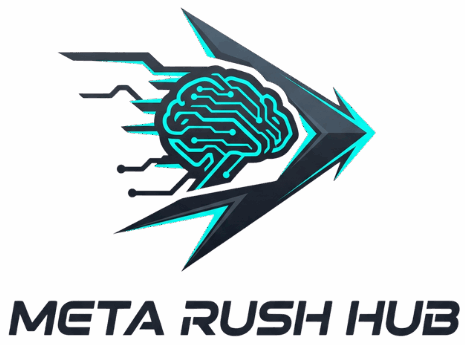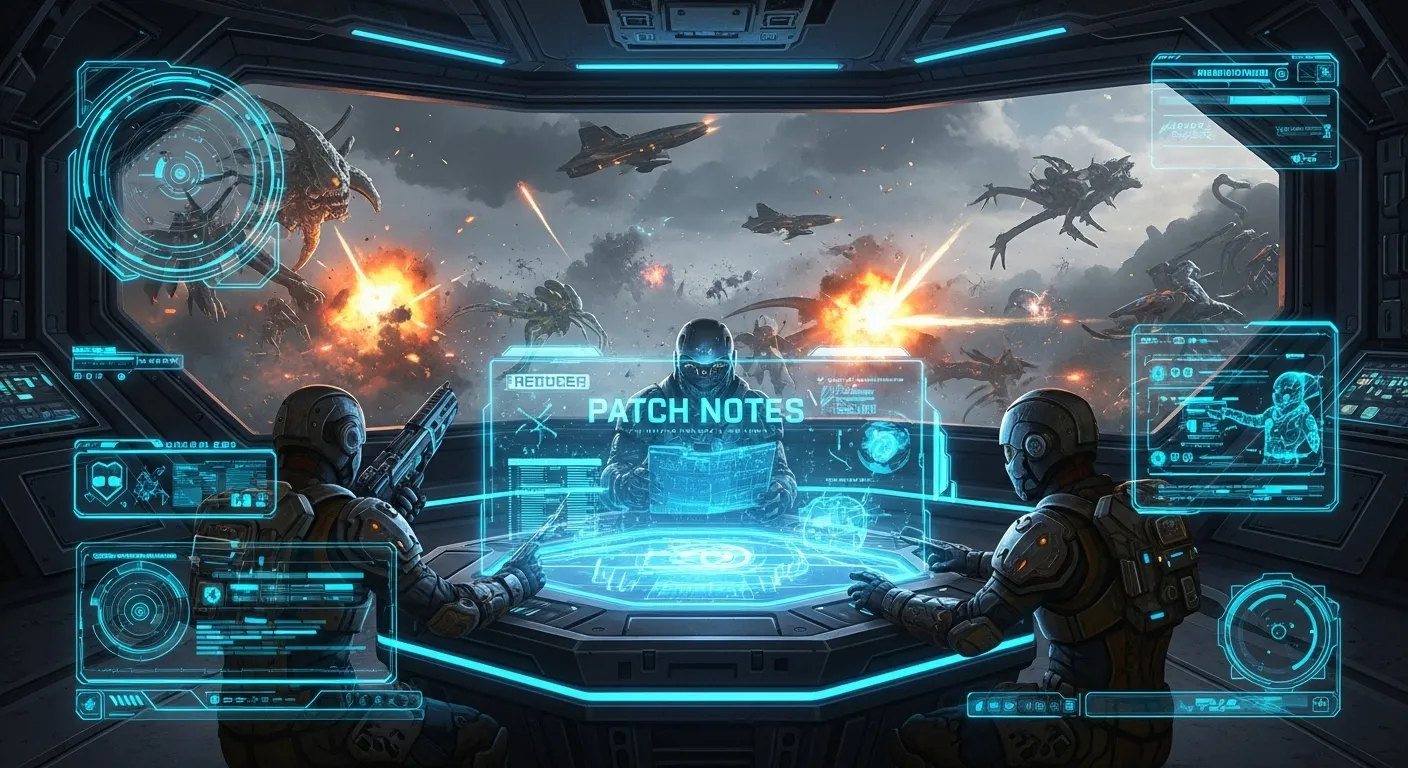I live for helldivers update patch notes. Buffs, nerfs, balance changes, bug fixes, release notes—hand it over. I read this stuff like a grocery list for chaos. Simple as that.
Why I read patch notes like they’re my morning coffee

I’ve been reading patch notes for over a decade. Not as a hobby. As survival training. If you don’t read them, you log in, call down a stratagem, and wonder why your gun suddenly kicks like a mule on roller skates. I’ve watched metas rise and burn out. I’ve lost squads because I missed one line that said “reduced explosive radius.” That tiny line hides a crater of pain.
Most studios write “release notes” to tell you what changed. But sometimes the real story is between the lines. That’s where I start circling phrases, mumbling to myself, and testing things in-game. If you don’t know the language, start by reading about release notes in general. It sets your brain to the right channel.
By the way, if you want a hub of patch write-ups I keep referencing, I stash a lot of my stuff under the big ol’ category called Patch Notes. I’m always adding fresh breakdowns when updates hit.
Arrowhead’s style: the calm before the nerf
What I’ve learned is this: Arrowhead Game Studios has a vibe. They’re the “we’ll tell you what we can tell you” type, and then they ship a hotfix 36 hours later because the Automaton dropships are lawnmowing entire lobbies. No shade; that’s the job. Big live game. Big fires. I like seeing how Arrowhead Game Studios writes, because once you know their tone, you can guess what’s coming next.
I also compare the new game to the old one. The original Helldivers taught me the rhythm of panic, team wipes, and blaming the squad’s fourth guy named Dave. Then Helldivers 2 cranked co-op chaos to eleven and added “whoops I called an orbital on your pod” as a core mechanic. Both taught me that patch notes are a living story of “Oops, too strong. Oops, too weak. Try again.”
The secret patch note dictionary (translated from dev-speak)
In my experience, patch notes have a language. You don’t need a PhD. You just need to know what to look for. Here’s my quick translation sheet I keep in my head.
- “Adjusted recoil” = It kicks more, or differently. Your muscle memory is now a liar.
- “Improved stability” = Fewer crashes, but also maybe fewer goofy bugs you secretly loved.
- “Reduced effectiveness at range” = Damage falloff got real. Don’t peek snipe with a toaster.
- “Fixed exploiting behavior” = You won’t solo a Bile Titan with a fork anymore.
- “Increased resource drop consistency” = You’ll get more mats, but not that many. Calm down.
- “Reworked” = Learn again from scratch. Pretend it’s a new weapon.
- “Improved matchmaking” = Queue times might get better. Or you’ll meet the same three players forever.
- “QoL” = Quality of life. Tiny changes. Big impact. Like a faster menu cursor. Or actually readable text.
So what actually shifts the meta?
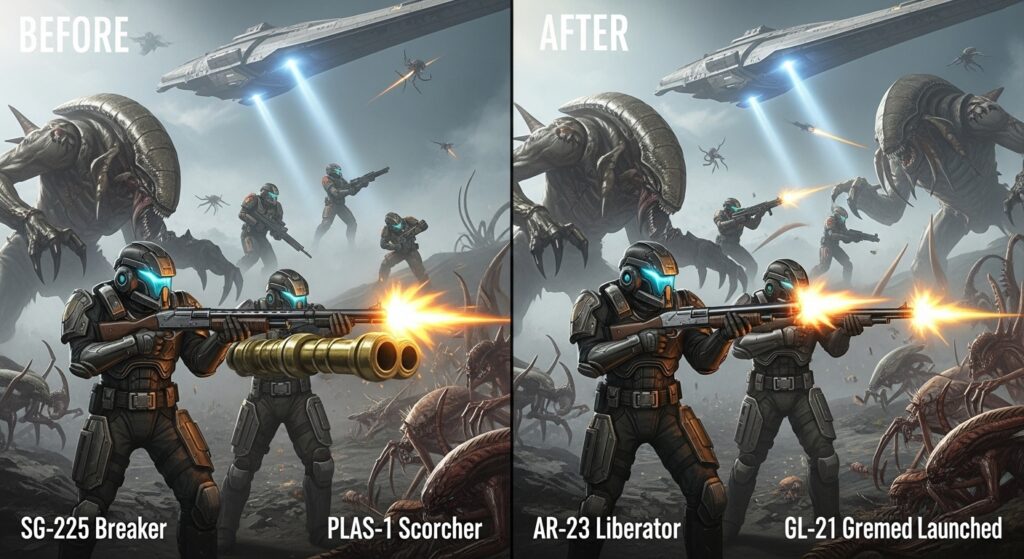
I’ve always found that one line about “splash damage tweaks” can erase weeks of muscle memory. Grenade launchers, autocannons, orbital strikes—small numbers, big effect. I saw it happen in other games too. I break those changes down with examples in my Palworld patch notes decoder because the same logic applies anywhere: numbers are behavior.
What I think is that Helldivers lives and dies on weapon feel. If a gun feels off, you trust it less. If you trust it less, you stop taking risky fights. That’s meta. Not just damage. Trust. When the trusty Breaker suddenly sprays wider, squads move slower. When the Railgun safe mode flips power down a notch, Titans survive, and your plan changes.
Stealth nerfs: not a conspiracy, just… normal
People call them “stealth nerfs” like the devs are sneaking around with a trench coat and a fake mustache. Relax. Half the time it’s a bug fix that affects a buff you liked. Or an unintended synergy got squashed. If you want a playbook for spotting this stuff, I wrote a quick how-to in my Fallout 76 patch notes decoder. Same habits, different ecosystem.
Here’s how I catch stealth changes anyway:
- Use the same test range and the same routine. Shoot the same target at the same distance. Time it.
- Count shots to kill. This never lies.
- Check stagger and stun. Sometimes that’s what changed.
- Test in co-op. Solo results can trick you when aggro splits in a squad.
- Look at recoil patterns after updates. Your thumb muscle has opinions.
“Patch” means more than you think
When we say patch, we mean a bundle of code that tweaks behavior. It’s not just balance. It’s performance, matchmaking, UI, everything. If you’ve never looked at the broader meaning, this primer on the concept of a patch in computing is helpful. Once you get that, you stop expecting every patch to be a perfect balance miracle. Sometimes it’s just fixing the ladder that tossed you into the sun.
What Helldivers changes do I watch hardest?
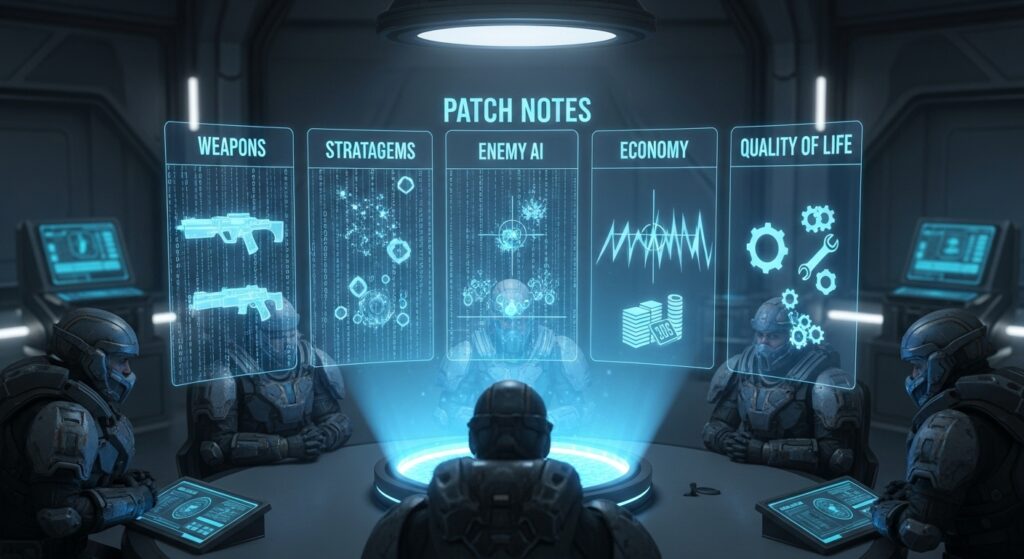
In my experience, there are five buckets that matter to real players, not spreadsheet goblins. You should check these first on patch day.
1) Weapon handling and damage model
- Recoil and spread changes. Especially on the Breaker, Liberator, Stalwart, and Dominator.
- Damage falloff ranges. Shotguns and ARs live here. Eruptor and Slugger care a lot.
- Penetration values. Armor is a cruel judge.
- Overheat and reload timings. Flamethrower, Heavy MG, Laser family. Tiny tweaks, huge vibes.
- Explosive radius and self-damage. Your squad survival depends on this not being surprising.
2) Stratagem timers and call accuracy
- Cooldown changes to Orbitals and Eagles. You’ll feel it in higher difficulties.
- Throw arc and placement accuracy. Airburst vs. “we just deleted a forest and ourselves.”
- Backpack behaviors. Shield pack drain. Guard Dog ammo. Supply pack restocks. The small stuff adds up.
3) Enemy AI and spawn density
- Patrol density shifts. You’ll notice it before you realize what’s wrong.
- Detection radius changes around objectives. Solo stealth routes get riskier overnight.
- Armor resist updates on big targets. Titans, Chargers, Devastators. This is the difference between “handled” and “call extraction now.”
4) Economy and mission payouts
- Medal and requisition reward tweaks. People will grind differently if this moves.
- Warbond prices and stock rotation. If it costs more, expect meta consolidation.
- Sample drop updates. Rare samples dictate late-game builds.
5) QoL and performance
- Crash fixes. You know when they work because nobody says anything. The silence is lovely.
- Input smoothing. Controller aim feeling “off” after a patch is a real thing.
- Matchmaking tweaks. Does your squad fill faster? That’s a huge win.
How I read a note line and turn it into real tactics
I’ve always found that a change to reload timing could mean switching out a backpack. If your Eruptor reloads slower, bring a Supply Backpack instead of the Shield Generator. If the Autocannon punishes you more on self-damage, you tighten formation and call targets. This is why I write cross-game breakdowns like my First Descendant patch notes guide. The craft isn’t about one game. It’s about reading changes and turning them into habits.
Here’s a simple example. Say patch notes say “reduced explosive radius slightly.” In practice, that means you:
- Stop pre-firing at the feet of teammates. Obviously.
- Aim tighter on big targets. Splash won’t save lazy aim.
- Reassign someone to bring EMP or Stun for crowd control backup.
The Warbond shuffle
When Warbonds shift, your whole squad’s kit shifts. If they lower cost on a middling rifle, guess what—more people run it, and suddenly you’re fighting swarms with less burst damage across the lobby. That changes mission pacing. If they buff the railgun or Quasar, Bile Titans become less scary, so squads lean greedy on objectives.
I keep an eye on what the broader scene does with these shifts too. If you’re into tracking what players are picking and why, the category I toss those discussions into is Multiplayer Trends. It’s where the “why is everyone running X this week?” talk lives.
The cadence of updates matters
One more practical thing: cadence. Weekly hotfixes feel very different from monthly balance passes. If you haven’t read up on the way teams package these updates, skim the idea behind proper release notes etiquette. It helps you not spiral when the first patch isn’t perfect. They’re often setting the table for the next two.
My basic patch-day routine
Here’s how I run my little lab whenever a new update lands. It’s boring. And it saves a lot of pain.
- Read the notes once, slow. Highlight anything that mentions weapons I use.
- Load a solo mission. Test fire at a fixed range. Count shots to kill. Time reloads with a stopwatch. Yes, really.
- Try three builds: my main, a budget version, and a meme build for fun.
- Run a quick difficulty mission with bots or friends. One objective max. Just feel it.
- Swap one variable at a time. Backpack or primary. Not both. Keep data clean-ish.
Why I care about the boring parts
Some patches talk about “server stability” and “backend improvements.” People glaze over. Don’t. That can change how often enemies teleport or how your bullets register. The netcode gremlins matter. When those smooth out, hit registration feels cleaner, and suddenly your Breaker beams feel “buffed,” even if they weren’t.
Past vs. present: reading the studio’s habits
I’ve been around long enough to remember the first game’s wild shifts. If you’ve never played it, skim the vibe of the original Helldivers. It sets context. You can guess how often this team is willing to touch balance, and how hard they’ll swing. Spoiler: they’re not shy.
Helldivers 2, though, amplified everything. Larger maps. Heavier weapons. Bigger mistakes. Brush up on the scope in Helldivers 2 and the design choices make the patch notes make sense. When the playground is this loud, little number tweaks echo.
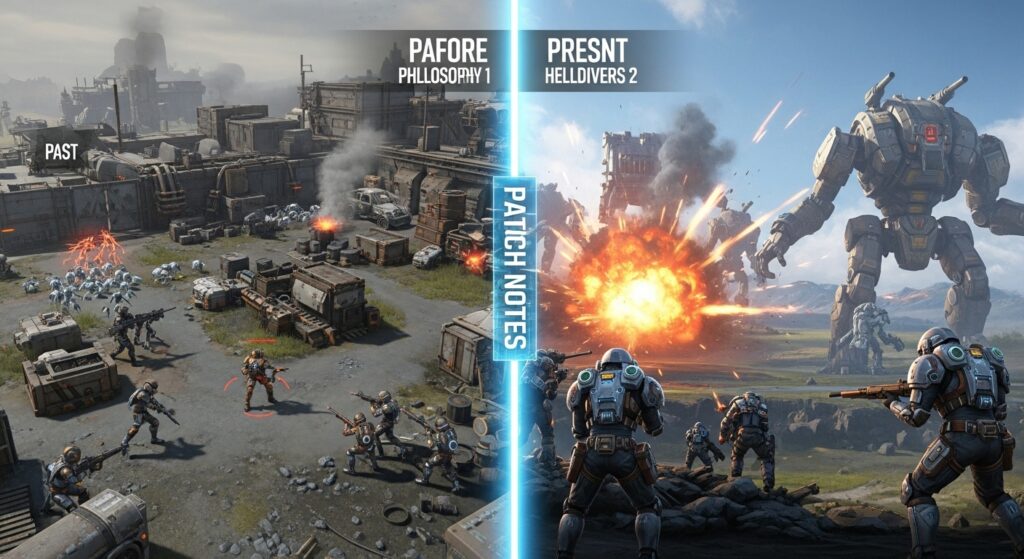
Some patch note lines I’ve learned to fear (and love)
- “Adjusted stagger thresholds on heavy units.” Translation: your stuns won’t save you every time.
- “Improved enemy pathing near objectives.” Translation: they’ll find your hiding spot now.
- “Increased resource drop consistency.” Translation: you’ll grind less, but not zero.
- “Improved input buffering for sprint and melee.” Translation: it feels better. You will notice.
- “Addressed an issue where [weapon] could overperform in niche cases.” Translation: someone posted a viral clip; it’s gone.
Quick reference “tables” (low-tech but handy)
Weapon feel changes checklist
- Recoil: Up/Down? Horizontal drift? Burst vs. full-auto?
- Spread: Hip-fire cone wider? ADS more stable?
- Damage: Body vs. weak points? Armor interaction?
- Reload/Handling: Mag time? Swap speed? ADS time?
- Special: Overheat, charge time, explosions, self-damage tweaks?
Stratagem synergy swaps to test after a patch
- Autocannon + Shield Pack → Try Autocannon + Supply Pack if reloads feel slower.
- Railgun + Stun Grenades → If safe mode got nerfed, add an Orbital to clean heavies.
- Breaker + Eagle Cluster → If splash got reduced, add Grenade Launcher for close cleanup.
- Stalwart + Guard Dog → If suppression got tweaked, swap to Laser Dog to cover runners.
Faction reaction list (what to change first)
- Terminids: If shotguns nerfed, bring more fire and stuns. Flamethrower + EMS mines.
- Automatons: If armor got thicker, bring Railgun/Recoilless, not meme builds.
- Mixed missions: Favor flexible primaries, spend stratagems faster. Don’t hoard.
Community habits that patch notes quietly reshape
I’ve seen patch notes change how people talk in voice chat. Before a nerf, everyone screams “Breaker!” After it, the vibe turns cautious. People ping more. Or they overcompensate and triple-stack orbitals on a scout. Balance is psychology. Changing numbers changes moods.
I also love how players mythologize lines like “slightly adjusted.” The whole Discord turns into a court case. Was it slight? Define slight. I’ve seen this happen across a lot of games, which is why I keep a running series on how patches ripple through player culture. If you like that sort of thing, I tag them under multiplayer trends to keep it tidy.
Yes, sometimes they miss stuff
Sometimes a note says “fixed an exploit” and it’s still there. Or they fix something that was fine and break three other things. Welcome to shipping software. If that stresses you out, peek at how a release note is supposed to work in theory. Reality’s messier. The team is probably juggling fires you’ll never see.
Let’s decode a pretend patch together
Here’s a made-up chunk I’ve used to teach friends. It reads like a normal bullet list, and you can practice reacting to it.
- “Breaker: increased recoil and slightly widened spread.” → Use shorter bursts. Close the gap. Consider Stalwart instead for mid-range.
- “Railgun: safe mode charge reduced.” → Stuns matter more. Pair with Stun Grenades or a teammate packing Recoilless.
- “Eagle Cluster: reduced outer ring damage.” → Place tighter. Don’t rely on edge hits to clear bugs.
- “Terminid patrol density increased.” → Don’t dawdle. Objectives first. Extraction early.
- “Supply pack restock speed improved.” → Put one in the squad. Sustain wins longer missions.
I treat each line like a small law of physics changed. You can get mad or you can adjust. Adjusting gets you medals. Getting mad gets you content for TikTok, I guess.
Why some notes feel vague (and why I don’t mind)
Devs sometimes keep numbers out of notes on purpose. If you publish exact values, players break out spreadsheets and declare winners by lunchtime. That kills experimentation. I like a little fog. It keeps me testing. Keeps squads creative. And honestly, exact numbers don’t translate well mid-firefight. “About two more bullets” is the only number my brain needs while a Charger is introducing itself.
A tiny nerd aside
If you’ve ever wondered why your favorite weapon “feels different” even if the notes don’t mention it, the answer lives in code. A patch can touch systems that ripple indirectly—animation, latency, physics. Your muscle memory notices. That’s not paranoia. That’s your hands doing QA.
Where I stash more breakdowns
I bundle my longer write-ups and watchlists under one spot so I don’t have to dig through old posts. If you’re hunting for a pattern, the archives live here: patch notes archives. It’s a firehose, but it’s organized.
Final quick hits I check after every update
- Did any backpack get a hidden stamina or speed penalty change?
- Do orbitals aim where I think they aim? Throw one on an empty patch and see.
- Is friendly fire damage unchanged? One “oops” will tell you fast.
- Does the stratagem input buffer feel snappier? It matters in red-alert fights.
- Any UI labels or icons updated? That usually hints at future tweaks.
Oh, and communication matters
The best studios talk to players. Arrowhead’s pretty open as far as game teams go. Could they be more specific sometimes? Sure. But I’d rather they ship and iterate than vanish for months. Knowing how Arrowhead approaches updates keeps my expectations healthy. Imperfect notes, fast hotfixes. I can live with that.
Want to practice reading notes across games?
I made a goofy but useful cross-checker using another title: my Palworld decoder again. Different universe. Same patch-reading brain. If you can spot a stealth change there, you’ll be a menace on Super Earth.
Changelog vs. reality
Remember this and you’ll be fine: the changelog is not the game. The game is the game. Notes are a signpost. You still have to walk. That means test, fail, tweak, laugh when your orbital deletes your team, and try again. That’s Helldivers. Democracy spreads. Sometimes it explodes.
Where this leaves me on patch day
On patch day, I brew coffee, open notes, sigh at the word “adjusted,” and go play. I’ll scribble a few lines, maybe rant a little, and update my running guides. If you want the general index of this stuff, it’s tagged here: all patch write-ups. New entries roll in after each update.
And yeah, sometimes I’m wrong
Sometimes I swear a weapon got nerfed and it didn’t. Turns out I just slept 3 hours and forgot how to aim. The point is to stay curious. Don’t cling to last week’s build like it’s sacred. Patch notes are an invitation to remix.
Mini case file: the “notes say nothing, game says everything” moment
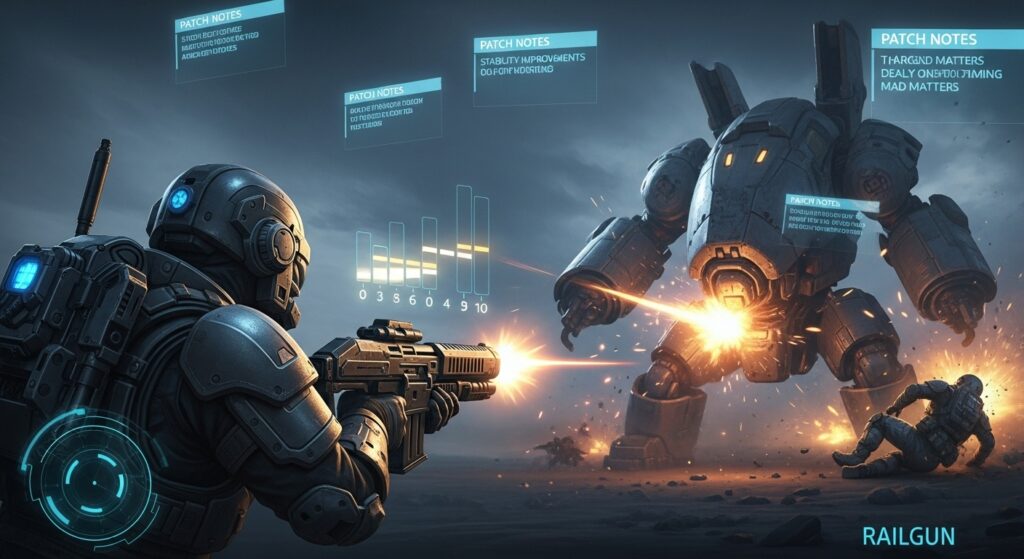
There was a patch where the notes said basically “stability improvements and some balance.” No numbers. Everyone shrugged. I jumped into a mission and instantly felt the Railgun charge cadence off by a hair. Not weaker. Just different timing. It changed the way I kited a Charger. I got smacked. Adjusted. Smiled. Played better after that. My friend didn’t read anything and kept dying in the same spot. That’s the edge you get from paying attention.
Why I still love this dance
I joke about it, but I like the chase. Reading, testing, arguing, adapting. It’s social, too. Half the fun is telling a friend “try the Stalwart again; it slaps now” and watching their face. Patch notes give us a reason to re-learn. When it’s rough, we grumble. When it’s good, we cheer. Both are fun if you let them be.
Oh, and if you’re totally new and wondering what any of this means, start by picking one weapon you love and track how it changes across a few updates. That’s your personal lab. Your tiny science project on Super Earth. After a few cycles, you’ll read helldivers update patch notes like a pro, even if you refuse to say “meta” out loud. I wouldn’t blame you.
One last nerd nibble
If you want a proper template for how notes should be structured (in a perfect universe), glance at how software teams define release notes. Then accept reality. Games are messy. Helldivers doubly so, because orbital lasers and insect guts.
I tag most of my comparisons and trend-spotting rants across games in, you guessed it, my multiplayer trends section. If you see me yelling about a stealth nerf in one game, it’s probably because I just saw the same tactic blow up in another.
And yeah, I’ll say the phrase one more time for the SEO gods and because you asked: helldivers update patch notes. It’s my bedtime story and my alarm clock. Don’t judge me.
FAQs
- Do I really have to read the notes every time? I mean, no one’s going to arrest you. But you’ll die fewer silly deaths if you skim them. Two minutes. Tops.
- How do I know if my favorite gun actually got nerfed? Shoot a fixed target at a fixed range after the patch. Count bullets to kill. If it’s more, it’s nerfed. If it’s the same but feels worse, recoil probably changed.
- Why don’t devs post exact numbers? Because numbers turn into arguments and kill experimentation. Also, sometimes they’re still tuning live. It’s not a courtroom.
- What should my squad change first after a balance patch? One thing at a time. Swap a backpack or one primary. Test a short mission. If it feels bad, roll back and try a different piece.
- Is it worth waiting for hotfixes before I dive in? If you hate pain, sure. I dive right in because I like figuring stuff out early. But hotfixes do come fast, so don’t marry any build on day one.

James Carter: Your competitive edge. I cover Patch Notes, Speedruns, Battle Royale Strategy, Multiplayer Trends, and Game Dev Insights. Let’s get into it!
